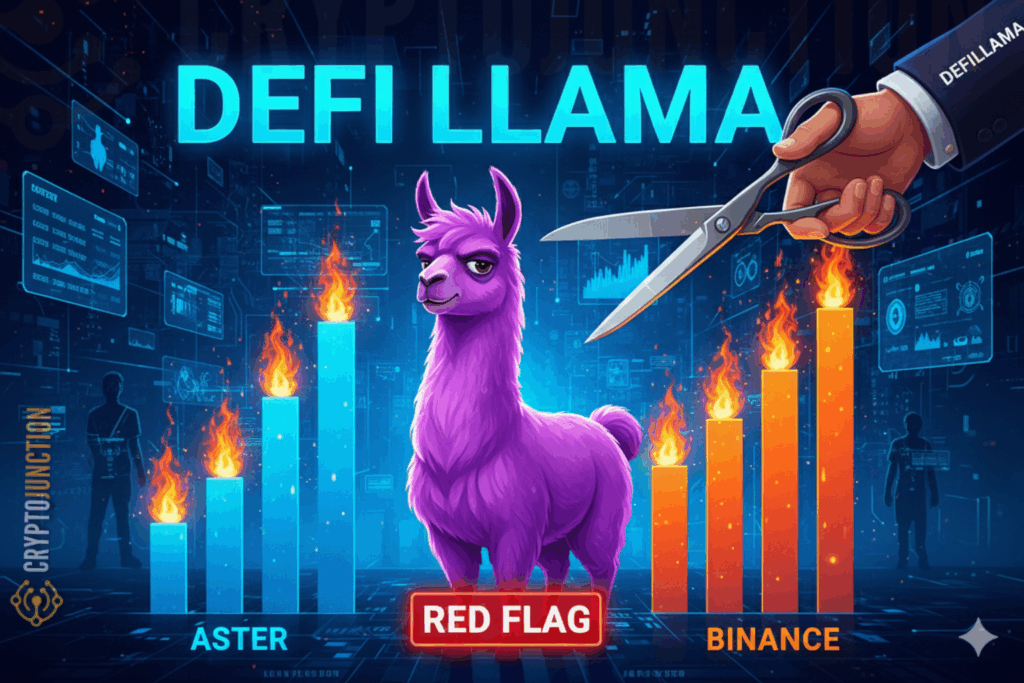DefiLlama, one of the most trusted analytics platforms in DeFi, made a bold move: it’s delisting Aster’s perpetual trading volume data over integrity concerns. The reason is as shocking as it is technical. Aster’s trading volumes closely mirrored Binance’s, with a correlation ratio near 1.0. For any decentralized exchange, analysts cannot ignore such an anomaly. When two platforms move in perfect sync, it’s not market efficiency — it’s a red flag.
According to DefiLlama’s pseudonymous co-founder 0xngmi, the lack of access to granular data such as who’s executing and filling orders, makes it impossible to verify if the trades are legitimate or just wash trading disguised as activity.
This is not just about Aster; it’s a reminder of how fragile credibility can be in DeFi when transparency goes missing.
DefiLlama Draws The Line Between Data And Deception
Aster’s rise was nothing short of meteoric. Within a week, open interest on the exchange surged by 33,500%, and daily perpetual trading volume exploded past $60 billion — numbers that put it shoulder to shoulder with giants like Hyperliquid.
But those same numbers now look suspiciously perfect. DefiLlama’s analysts noticed Aster’s trading behavior mirroring Binance’s volumes nearly tick-for-tick, an impossibility for any independent DEX.
The bigger concern? Aster doesn’t offer open access to its lower-level order data. That means there’s no way to check if a few entities are inflating the numbers through self-trading or algorithmic manipulation. Without that proof, DefiLlama has chosen integrity over hype, delisting the data until further notice.
And the crypto crowd took notice. In an ecosystem obsessed with transparency, DefiLlama’s stance reinforces its role as the truth filter of DeFi analytics — a line few platforms are bold enough to draw.
DefiLlama’s Move Shakes Aster’s Future Prospects
Aster was positioned as the rising star of decentralized perpetuals, quickly becoming a competitor to Hyperliquid. Its association with CZ, Binance’s co-founder, gave it instant clout and attention. Traders speculated that Aster could outperform Hyperliquid in both volume and user activity.
But DefiLlama’s delisting cuts deep. Without verified data, institutional analysts and retail traders alike lose visibility into the exchange’s true performance. Transparency is DeFi’s backbone — and losing that trust can be fatal for a platform trying to scale.
Despite the setback, Aster’s token (currently around $1.83) still shows resilience. Analysts remain split — some believe the delisting is a temporary blow that will fade as Aster addresses transparency concerns, while others see it as a sign of deeper structural flaws.
What’s undeniable is the timing: October historically favors crypto markets, and if Aster cleans up its data fast, it might still catch the next leg of bullish sentiment.
The Signal Behind The Noise
DefiLlama’s decision marks a turning point for DeFi analytics. It’s no longer enough for a protocol to show flashy numbers — those numbers need to be provable. The delisting sends a clear signal to other platforms: data integrity is non-negotiable.
As for Aster, this moment could define its reputation. The exchange must open its data to reclaim trust, or people will remember it as another platform that burned bright and vanished faster than its volume chart could refresh.
In DeFi, credibility isn’t built with volume; it’s built with verifiable truth. And DefiLlama just reminded everyone of that.
Conclusion
Aster’s rise was the story every DeFi trader wanted to believe. But DefiLlama’s intervention turned admiration into scrutiny. If transparency is the price of credibility, Aster must pay it fast — because in crypto, once doubt creeps in, even billions in volume can’t buy back trust.

